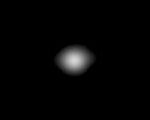Adrastea (moon)
| Adrastea | |
|---|---|

|
|
| Jupiter's moon Adrastea, on December 19, 1996, captured by the Galileo spacecraft at a distance of 658,000 km. | |
| Provisional or systematic name | S / 1979 J 1 |
| Central body | Jupiter |
| Properties of the orbit | |
| Major semi-axis | 129,000 km |
| Periapsis | 128,800 km |
| Apoapsis | 129,200 km |
| eccentricity | 0.0018 |
| Orbit inclination | 0.054 ° |
| Orbital time | 0.298 d |
| Mean orbital velocity | 31.48 km / s |
| Physical Properties | |
| Albedo | 0.100 |
| Apparent brightness | 18.7 mag |
| Medium diameter | 16.4 ± 4 km |
| Dimensions | 7.49 × 10 15 kg |
| surface | 845 km 2 |
| Medium density | 3.0 g / cm 3 |
| Sidereal rotation | 0.298 |
| Axis inclination | 0 ° |
| Acceleration of gravity on the surface | 0.007 m / s 2 |
| Escape speed | 0 -10.6 m / s |
| discovery | |
| Explorer |
David C. Jewitt, G. Edward Danielson |
| Date of discovery | July 8, 1979 |
| Remarks | Simply bound rotation, smallest of the Amalthea group |
Adrastea (also Jupiter XV ) is the second innermost known Jupiter moon and the smallest of the Amalthea group .
discovery
Adrastea was discovered on July 8, 1979 by the astronomers David C. Jewitt and G. Edward Danielson on recordings of the space probe Voyager 2 and was initially given the provisional designation S / 1979 J 1 . In 1983 the moon was officially named after Adrasteia , a goddess from Greek mythology who is responsible for distributing reward and punishment.
Orbit data
Adrastea moves within Jupiter's ring system and, together with Metis, is probably a source for the ring particles. It orbits Jupiter within the rotationally synchronous orbital radius and is exposed to the strong tidal forces of the giant planet. The moon is small enough not to be torn apart by the forces, but its orbit - like that of the innermost moon Metis - will decrease in the future, so that it will eventually crash on Jupiter.
Adrastea is within the Roche limit for liquid moons; That is, it is only stable through the cohesion of its material. The escape speed in the table therefore only applies to a movement at right angles to the gas planet .
Structure and physical data
Adrastea measures about 20 × 16 × 14 kilometers, which corresponds to a mean diameter of 16.4 kilometers. Its density of 4.5 g / cm 3 suggests that it is mainly composed of silicate rock and larger proportions of iron . Its area is 844.96 km².
It has a very dark surface with an albedo of 0.05, i.e. that is, only 5% of the incident sunlight is reflected. Their apparent brightness is 18.7 m . Adrastea rotates around its own axis in 7 hours and 9 minutes and thus, like the earth's moon , shows a bound rotation .
Web links
- IAUC 3454: Editorial Notice February 25, 1980 (discovery)
- IAUC 3872: Satellites of Jupiter and Saturn September 30, 1983 (numbering and naming)
- https://planetarynames.wr.usgs.gov/Page/Planets
- https://solarsystem.nasa.gov/planets/adrastea/facts
- http://solarviews.com/germ/adrastea.htm
- http://www.planetary.org/multimedia/space-images/jupiter/adrastea.html
Individual evidence
- ↑ a b [1] , vestibules, mean orbital velocity, diameter calculated from this
- ↑ https://solarsystem.nasa.gov/moons/jupiter-moons/adrastea/in-depth/
- ↑ NASA data sheet ( Memento from September 17, 2008 in the Internet Archive )
| before | Jupiter moons | after that |
| Thebe | Adrastea |
Metis |

